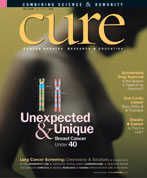Publication
Article
CURE
Accelerated Drug Approval: Taming the Shortcut?
Author(s):
Accelerated process speeds drugs to the patient, but some rally for changes to the system.
On the face of it, the June 17, 2005 announcement seemed an innocuous shred of red tape. The Food and Drug Administration was changing the way AstraZeneca could label its anti-cancer drug Iressa (gefitinib). Just a wording change.
But that wording change spoke volumes. The FDA was essentially pulling its approval from Iressa by making distribution so restrictive that it had returned to being an experimental drug, and the only people who could get it were those currently showing benefit or subjects in clinical trials.
Although AstraZeneca continues to test the drug for potential niche markets (initial studies show a higher response rate among Asian lung cancer patients for reasons not fully understood), it will take the company years to do enough testing to convince the agency to give full approval. Luckily, patients can look to an alternative therapy called Tarceva (erlotinib), a new drug that acts on the same molecular pathway as Iressa. Nevertheless, for the first time, a drug that received accelerated approval has been pulled. And a series of other accelerated approval applicants has met with hardships or downright rejection from the FDA’s advisory committees. Is this just a one-time confluence of coincidences or the beginning of a new, stricter policy at the FDA?
Most experts, and the FDA itself, say the accelerated approval process is alive and well. Richard Pazdur, MD, director of the FDA’s newly formed Office of Oncology Drug Products, says commercial sponsors and the agency have gained increasing experience with the process to expedite drugs to the American public. He says the Iressa issue only demonstrates that the accelerated approval process works.
“At the time Iressa was approved, there were no other therapies for refractory lung cancer,” says Pazdur. “Subsequently, Tarceva was approved, and several randomized confirmatory trials failed to demonstrate the benefit of Iressa.” “Iressa is a one-off event,” says Charles Bennett, MD, PhD, an oncologist at Northwestern Comprehensive Cancer Center in Evanston, Illinois, who has studied the process. “It’s not a policy shift or paradigm.” What is happening, Bennett and others say, is that the FDA is dealing with a flood of new experimental cancer drugs, and with the hits come misses. Among the Gleevec (imatinib) and Erbitux (cetuximab) success stories of accelerated approval, there are bound to be failures like Iressa. In addition, Zarnestra (tipifarnib), a drug for acute myeloid leukemia patients, was denied accelerated approval in May of this year but is still in phase III testing and may be resubmitted for approval in two to three years.
At the heart of the accelerated approval system is the simple desire to make drugs that appear to offer hope to otherwise untreatable maladies available to patients as early as possible. A typical drug approval can take five to 10 years after the initial application. In the early 1990s, AIDS activists demanded a shortcut for promising drugs, even if the data were incomplete. In 1992, the FDA responded by revamping an earlier, little-used compassionate care program (see sidebar, page 40) into an official accelerated approval system, complete with official benchmarks and phone-book-size regulatory manuals.
To qualify for the system, a drug must show significant potential to treat a disease that otherwise has no treatment. An accelerated approval drug doesn’t need to show a clinical endpoint (proof that the disease is being cured or deaths are being reduced), but there must be compelling evidence to believe that progress is being made in fighting the disease or symptoms are being relieved. That evidence can be physical (tumor shrinkage) or it can be relational (a decrease in a protein that tends to appear when cancer is present). It also doesn’t have to be overwhelmingly convincing. Data from clinical studies that test only a few dozen or a few hundred patients can be submitted, whereas thousands of subjects in double-blinded studies must be tested for full approval.
“Drugs approved under accelerated approval are based on a surrogate that is reasonably likely to predict clinical benefit,” says Pazdur. “Therefore, there is an element of risk acknowledged by the FDA in approving drugs under accelerated approval.” Pazdur notes that accelerated approval is meant to be only a temporary measure. Drug companies are required to do full studies to prove the drug is safe and effective. But he says accelerated approval can negatively impact patient accrual for these studies. “The approval has implications for completion of confirmatory trials since oncologists and patients have commercial access to the drug after accelerated approval.”
Vicki Vandamme found herself on the Iressa roller coaster. An avid windsurfer from Marin County, California, the 51-year-old nonsmoker saw minor shrinkage of her lung tumor while on chemotherapy. She was then put on Iressa, but her June 16 checkup proved that Iressa wasn’t working. The tumor had grown and spread to her lymph nodes. The FDA announced its stricter labeling provision for Iressa just one day later.
At the heart of the accelerated approval system is the simple desire to make drugs that appear to offer hope to otherwise untreatable maladies available to patients as early as possible.
Vandamme, who is adamant she can beat the disease, is back on chemotherapy and hopes to start Tarceva soon.
Although the Iressa case is the first example of effective withdrawal of an accelerated approval drug, the case of Zarnestra sheds more light on the accelerated approval process.
When Zarnestra was denied accelerated approval in May, some patient advocates and pundits publicly voiced concern that the accelerated approval process, meant to be an expressway, was now slowing to a crawl. A closer look at the Zarnestra story, however, shows that this wasn’t a bureaucratic slowdown. For one thing, the 11-member panel wasn’t unanimous in its recommendation. The final vote was seven to four.“It was a very heated debate and it wasn’t an easy decision to make,” says Art Flatau, a leukemia survivor who represented patients on the committee. Flatau voted against approval. “I just didn’t see the compelling evidence.”
Flatau and the other committee members who voted against accelerated approval had reason to be skeptical. Only 136 elderly, newly diagnosed AML patients were evaluated in the phase II trial used to support Zarnestra’s approval. Johnson & Johnson, maker of the drug, claimed that 15 percent of patients had a complete remission. Flatau compared that success rate with chemotherapy results, which, according to a database search by fellow panel member and M. D. Anderson Cancer Center leukemia specialist Susan O’Brien, MD, can be as high as 40 percent remission. Topping Flatau’s concerns was the fear that many elderly patients would choose the drug, if approved, over chemo-therapy out of a fear of side effects. “It’s clear that this drug is safer than chemotherapy,” he says, but adds that there’s no evidence it’s more effective.
Ronald Bukowski, MD, director of experimental therapeutics at the Cleveland Clinic and another member of the FDA committee, disagreed with Flatau and voted for the accelerated approval of Zarnestra. That doesn’t mean he was satisfied with the data, though. “The trial should have been designed for patients that aren’t eligible for chemotherapy,” he says. Johnson & Johnson is enrolling patients in a phase III trial for newly diagnosed AML patients 70 and older.
Zarnestra isn’t the only issue that has upset FDA critics. Rep. Edward Markey of Massachusetts published a staff report in June that quantified another argument against the early approval process. His office did a public records search of drugs that received accelerated approval and then failed to do the required follow-up studies. According to the report, half failed to do the required studies. “The system is broken,” he said in a June press conference.
The FDA disagrees. Robert Temple, MD, associate director of the agency’s office of medical policy, points out that of the 24 oncology-related drugs that have received accelerated approval, nine have been upgraded to full approval after follow-up studies. Of the other 15, seven were just approved in the past two years—not nearly long enough to complete a full phase III trial. “And the rest are working on studies,” says Temple. “It’s not a useful observation to say that the drug companies haven’t finished their trials in such a short time frame.”
Temple insists the system isn’t broken but that it could stand a tune-up. He points out that the structure of trials is crucial. “We’re much more interested in seeing the early results from a large randomized trial than the early results from a small trial,” he says. In other words, if the early results of a phase III trial are promising enough, the ears at the FDA will be more sympathetic toward accelerated approval. “That way, the follow-up data are already in the process of being collected.”
Indeed, most experts agree the accelerated approval process isn’t in need of an overhaul but could use some minor tinkering to correct fixable flaws. Bennett lauds the program for its success rate, but he is still anxious about the tendency to approve drugs that have been tested in few subjects because “it raises some safety questions,” he says.
Nevertheless, Bennett says the positives outweigh the negatives of the program. According to his data, accelerated approval knocks hundreds of days from the typical time it takes a drug to get full approval. And on each of those days, patients with terminal diseases have access to drugs they otherwise wouldn’t have a chance to get.
Indeed, most experts agree the accelerated approval process isn’t in need of an overhaul but could use some minor tinkering to correct fixable flaws.






